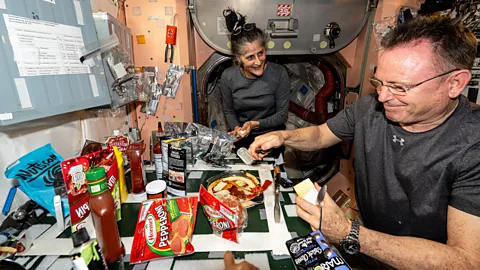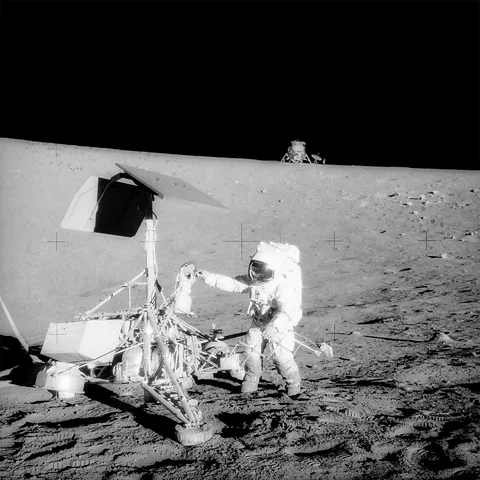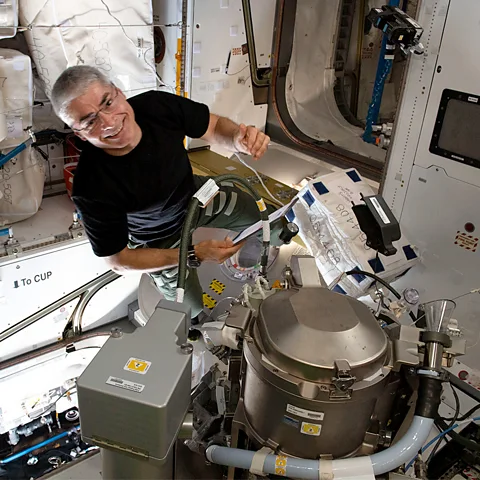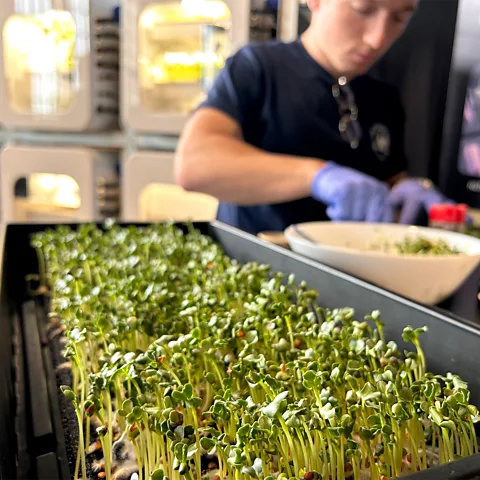 Nasa/ Esa
Nasa/ EsaWhen astronauts land on the Moon again as part of the Artemis project, they will have to build a place to live in. Nasa wants them to build as much of it they can from used materials.
When the first men landed on the Moon in 1969, sustainability was the least of their concerns. To save weight before they headed home the Apollo astronauts tossed anything they didn’t need out of the door of the lunar lander, leaving the landing sites littered with debris.
Nasa’s official tally of what the 12 Moonwalkers left behind includes 96 bags of urine, faeces and vomit, as well as boots and life support systems. The astronauts discarded three lunar rovers, assorted experiments and cameras, six flags, a family photo, a feather and two golf balls – hit “miles and miles” by Apollo 14 commander Alan Shepard. The list also includes one hundred $2 bills (£1.58) – rare enough on Earth but now arguably the most valuable Earth currency in the Universe. Don’t trade your Bitcoin in just yet, though, as the ink on the banknotes may have faded to nothing in the harsh UV rays of the Sun.
“There’s no erosion, there are no dust storms that will cover them up or hide them,” says Chris Impey, a professor of astronomy at the University of Arizona and an expert on space junk. “They are there forever.”
For historic missions like Apollo that is not really a problem. Neil Armstrong’s first footsteps on the lunar surface mark arguably one of the greatest achievements of humanity and the challenge for the US will be to preserve the landing sites in their original state – from footsteps and Moon buggies, to golf balls and excrement bags.
“The Americans in some sense would love that area to be a sort of national park or protected area,” says Impey. “But there’s no rule. If an entrepreneur wants to make a virtual theme park out of the Apollo landing sites in the future, they could do it.”
When humans return to the Moon and establish a base, the rubbish and waste of a new generation of lunar astronauts is not going to have the same historic value. Instead, Nasa plans to adopt the philosophy from Earth of reduce, reuse and recycle. And the primary motivation is practical.
 Nasa
Nasa“Flying anything from Earth is so expensive because you need so much rocket fuel,” says Jennifer Edmunson, who heads up Nasa’s latest Centennial Challenge programme called LunaRecycle. “It costs $1m to $1.2m (£790,000 to £950,000) to fly a single kilogram from Earth to the Moon.”
“Any kind of recycling that we could do there is completely beneficial to the economy,” Edmunson says. “Not only that, we want to preserve the Moon as the amazing place it is and not turn it into a landfill.”
Nasa hopes its $3m (£2.37m) LunaRecycle competition will encourage entrants from all over the world to come up with innovative ways to recycle materials.
“Centennial Challenges is one of the coolest programs that Nasa does, because we get to crowdsource ideas from all different walks of life,” says Edmunson. “We’re looking at things like plastics, metals and materials like bubble wrap or fabric and just any scrap material that you might have lying around.”
“So [maybe] we can transform a food package into, say, a spoon, or storage containers or artwork even – to create a lunar habitat environment that is homey, essentially,” says Edmunson.
While no-one is suggesting scavenging the remains of Armstrong’s Apollo 11 or the early Soviet missions (the Soviet Union was the first nation to land a probe on the Moon) to create cutlery or abstract art, there is plenty of other hardware on the lunar surface that is perhaps less valuable. The US, for example, has several Surveyor landers and a number of crashed lunar satellites that might be stripped for parts and materials.
“We’ve actually talked about using some of the old landers that are there and mining the aluminium off of them,” says Edmunson. But while this might sound sensible, the reason Nasa has issued the challenge for ideas is that none of this is going to be easy.
“You would be operating in low gravity, high vacuum and surrounded by lunar dust,” warns Geoff Brooks, professor in sustainable minerals processing at Swinburne University of Technology in Melbourne, Australia.
 Nasa
NasaWhile processing materials, such as metals or plastics, in a vacuum might be an advantage, says Brooks: “The low gravity presents challenges for separating materials and the sticky and abrasive dust is very bad for moving machinery and is just a general nuisance.”
With no atmosphere on the Moon – and therefore no convection – there is also the challenge of cooling the equipment and removing any toxic fumes or residue. Brooks’ research includes developing techniques to extract and process lunar minerals – including metals – and turn them into useful materials with concentrated heat from the Sun (you can see a lecture on his work here). His “lunar steel”, for example, would use readily available silicon in the process rather than the carbon that is used here on Earth.
“But if we are clever from the start, we can minimise the need for mining on the Moon and the expense of bringing materials to the Moon,” says Brooks. “This is one of the great challenges of maintaining a community on the Moon.”
Although this latest Nasa challenge is only seeking ideas for recycling non-toxic materials, when it comes to other forms of recycling that future astronauts will need on the Moon, Nasa has come a long way since 1969.
“The astronauts on the International Space Station (ISS) call their coffee yesterday’s water, because the urine is recycled,” says Kelly Weinersmith, co-author of A City on Mars, which investigates the practicalities of settling the Moon and Mars. In fact, right now, after some recent plumbing repairs and additions, Nasa says the water recycling system on the ISS is running at a record 98% efficiency. This means that almost all astronaut urine, sweat and moisture from their breath is recycled back into drinking water.
This is what is known as a closed-loop recycling system, where almost every bit of waste is turned back into something useful. On Earth we often spread animal and human waste, or composted waste, on the soil to grow crops. If we wanted to grow food on the Moon – which we will almost certainly have to do – it would make sense to use astronaut waste for fertiliser. But only the new stuff.
 Nasa
Nasa“Nasa would really prefer for you to not grow your tomatoes in Neil Armstrong’s long-lost bowel movements because everything the Apollo astronauts left behind is considered Nasa heritage,” says Weinersmith.
When it comes to this sort of biological recycling, China has had recent success in creating a simulated space habitat on Earth. During the Lunar Palace-1 experiment at Beihang University in Beijing in 2017-18 (Palace is actually an acronym standing for Permanent Astrobase Life-support Artificial Closed Ecosystem), volunteers spent up to 200 days at a time living in a sealed environment and consuming recycled air, water and food.
“One of the great recycling tricks that they used was they had mealworms which eat the parts of the plants that they couldn’t consume,” says Weinersmith. “Then those mealworms are your protein source and so they would put spice on the mealworms, and they would eat the mealworms – in that way they were able to make use of just about everything that they had.”
So, the immediate future reality of space exploration might fail to live up to the science fiction dream of shiny corridors and food replicators. Instead, any Moonbase is likely to be dusty and cramped with furniture fashioned from redundant spacecraft and a diet of salad and mealworms grown in human waste, washed down with instant coffee that was yesterday’s urine.


